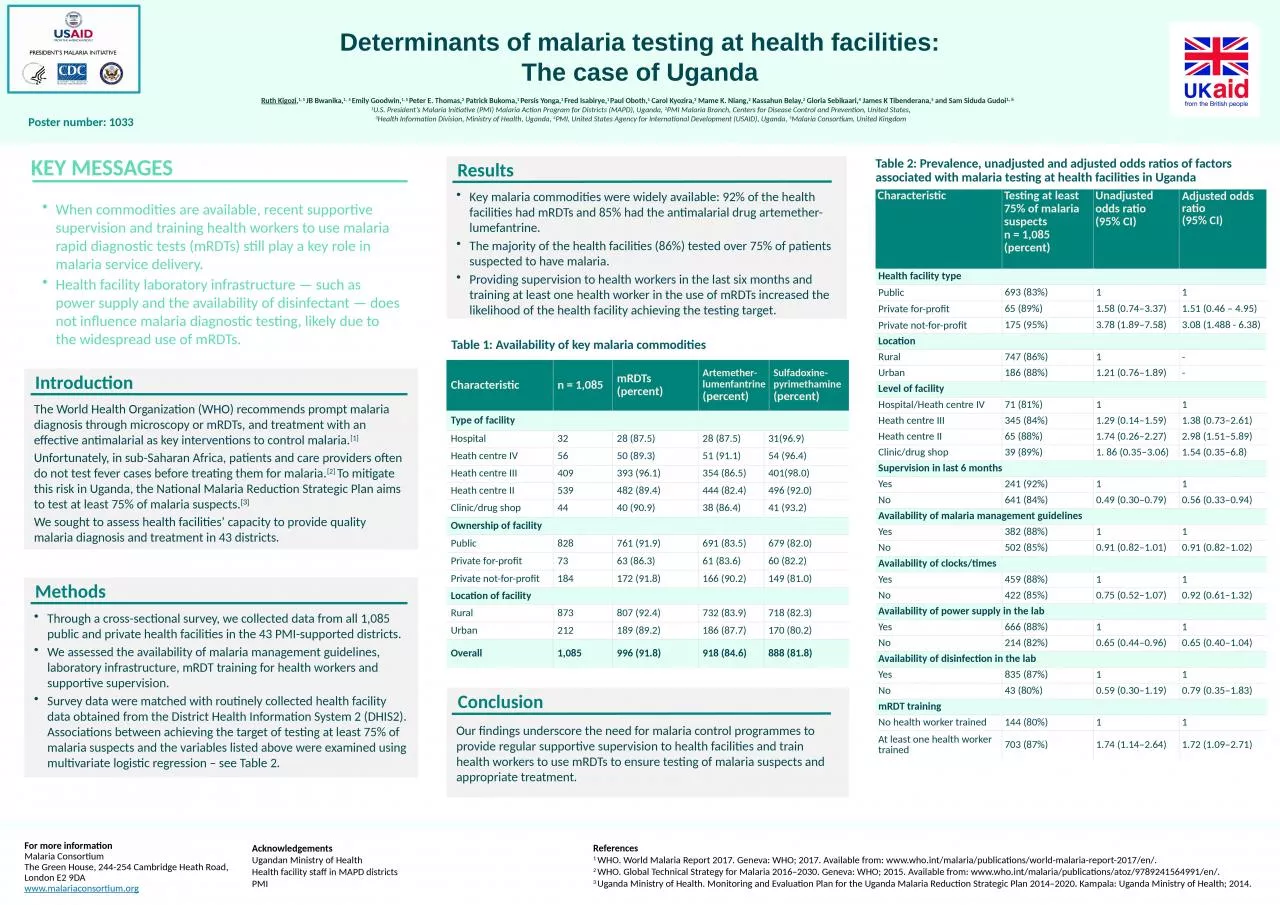

1 5 JB Bwanika 1 5 Emily Goodwin 1 5 Peter E Thomas 2 Patrick Bukoma 1 Persis Yonga 1 Fred Isabirye 1 Paul Oboth 1 Carol Kyozira 3 Mame K ID: 1036975
Download Presentation The PPT/PDF document "Methods Introduction Ruth Kigozi" is the property of its rightful owner. Permission is granted to download and print the materials on this web site for personal, non-commercial use only, and to display it on your personal computer provided you do not modify the materials and that you retain all copyright notices contained in the materials. By downloading content from our website, you accept the terms of this agreement.
1. MethodsIntroductionRuth Kigozi,1, 5 JB Bwanika,1, 5 Emily Goodwin,1, 5 Peter E. Thomas,2 Patrick Bukoma,1 Persis Yonga,1 Fred Isabirye,1 Paul Oboth,1 Carol Kyozira,3 Mame K. Niang,2 Kassahun Belay,2 Gloria Sebikaari,4 James K Tibenderana,5 and Sam Siduda Gudoi1, 5 1U.S. President’s Malaria Initiative (PMI) Malaria Action Program for Districts (MAPD), Uganda, 2PMI,Malaria Branch, Centers for Disease Control and Prevention, United States, 3Health Information Division, Ministry of Health, Uganda, 4PMI, United States Agency for International Development (USAID), Uganda, 5Malaria Consortium, United KingdomDeterminants of malaria testing at health facilities: The case of UgandaReferences1 WHO. World Malaria Report 2017. Geneva: WHO; 2017. Available from: www.who.int/malaria/publications/world-malaria-report-2017/en/.2 WHO. Global Technical Strategy for Malaria 2016–2030. Geneva: WHO; 2015. Available from: www.who.int/malaria/publications/atoz/9789241564991/en/.3 Uganda Ministry of Health. Monitoring and Evaluation Plan for the Uganda Malaria Reduction Strategic Plan 2014–2020. Kampala: Uganda Ministry of Health; 2014.The World Health Organization (WHO) recommends prompt malaria diagnosis through microscopy or mRDTs, and treatment with an effective antimalarial as key interventions to control malaria.[1] Unfortunately, in sub-Saharan Africa, patients and care providers often do not test fever cases before treating them for malaria.[2] To mitigate this risk in Uganda, the National Malaria Reduction Strategic Plan aims to test at least 75% of malaria suspects.[3] We sought to assess health facilities’ capacity to provide quality malaria diagnosis and treatment in 43 districts.Our findings underscore the need for malaria control programmes to provide regular supportive supervision to health facilities and train health workers to use mRDTs to ensure testing of malaria suspects and appropriate treatment. Table 1: Availability of key malaria commoditiesCharacteristicn = 1,085mRDTs (percent)Artemether-lumenfantrine(percent)Sulfadoxine-pyrimethamine(percent)Type of facilityHospital3228 (87.5)28 (87.5)31(96.9)Heath centre IV5650 (89.3)51 (91.1)54 (96.4)Heath centre III409393 (96.1)354 (86.5)401(98.0)Heath centre II539482 (89.4)444 (82.4)496 (92.0)Clinic/drug shop4440 (90.9)38 (86.4)41 (93.2)Ownership of facilityPublic828761 (91.9)691 (83.5)679 (82.0)Private for-profit7363 (86.3)61 (83.6)60 (82.2)Private not-for-profit184172 (91.8)166 (90.2)149 (81.0)Location of facilityRural 873807 (92.4)732 (83.9)718 (82.3)Urban212189 (89.2)186 (87.7)170 (80.2)Overall1,085996 (91.8)918 (84.6)888 (81.8)ConclusionWhen commodities are available, recent supportive supervision and training health workers to use malaria rapid diagnostic tests (mRDTs) still play a key role in malaria service delivery. Health facility laboratory infrastructure — such as power supply and the availability of disinfectant — does not influence malaria diagnostic testing, likely due to the widespread use of mRDTs. Table 2: Prevalence, unadjusted and adjusted odds ratios of factors associated with malaria testing at health facilities in UgandaCharacteristicTesting at least 75% of malaria suspects n = 1,085 (percent)Unadjusted odds ratio (95% CI)Adjusted odds ratio (95% CI)Health facility typePublic693 (83%)11Private for-profit65 (89%)1.58 (0.74–3.37)1.51 (0.46 – 4.95)Private not-for-profit175 (95%)3.78 (1.89–7.58)3.08 (1.488 - 6.38)Location Rural747 (86%)1-Urban186 (88%)1.21 (0.76–1.89)-Level of facilityHospital/Heath centre IV71 (81%)11Heath centre III345 (84%)1.29 (0.14–1.59)1.38 (0.73–2.61)Heath centre II65 (88%)1.74 (0.26–2.27)2.98 (1.51–5.89)Clinic/drug shop39 (89%)1. 86 (0.35–3.06)1.54 (0.35–6.8)Supervision in last 6 months Yes241 (92%)11No641 (84%)0.49 (0.30–0.79)0.56 (0.33–0.94)Availability of malaria management guidelinesYes382 (88%)11No502 (85%)0.91 (0.82–1.01)0.91 (0.82–1.02)Availability of clocks/timesYes459 (88%)11No422 (85%)0.75 (0.52–1.07)0.92 (0.61–1.32)Availability of power supply in the labYes666 (88%)11No214 (82%)0.65 (0.44–0.96)0.65 (0.40–1.04)Availability of disinfection in the labYes835 (87%)11No43 (80%)0.59 (0.30–1.19)0.79 (0.35–1.83)mRDT training No health worker trained144 (80%)11At least one health worker trained703 (87%)1.74 (1.14–2.64)1.72 (1.09–2.71)AcknowledgementsUgandan Ministry of HealthHealth facility staff in MAPD districtsPMIThrough a cross-sectional survey, we collected data from all 1,085 public and private health facilities in the 43 PMI-supported districts.We assessed the availability of malaria management guidelines, laboratory infrastructure, mRDT training for health workers and supportive supervision. Survey data were matched with routinely collected health facility data obtained from the District Health Information System 2 (DHIS2). Associations between achieving the target of testing at least 75% of malaria suspects and the variables listed above were examined using multivariate logistic regression – see Table 2.Key malaria commodities were widely available: 92% of the health facilities had mRDTs and 85% had the antimalarial drug artemether-lumefantrine. The majority of the health facilities (86%) tested over 75% of patients suspected to have malaria. Providing supervision to health workers in the last six months and training at least one health worker in the use of mRDTs increased the likelihood of the health facility achieving the testing target.KEY MESSAGESPoster number: 1033For more informationMalaria ConsortiumThe Green House, 244-254 Cambridge Heath Road, London E2 9DAwww.malariaconsortium.orgResults